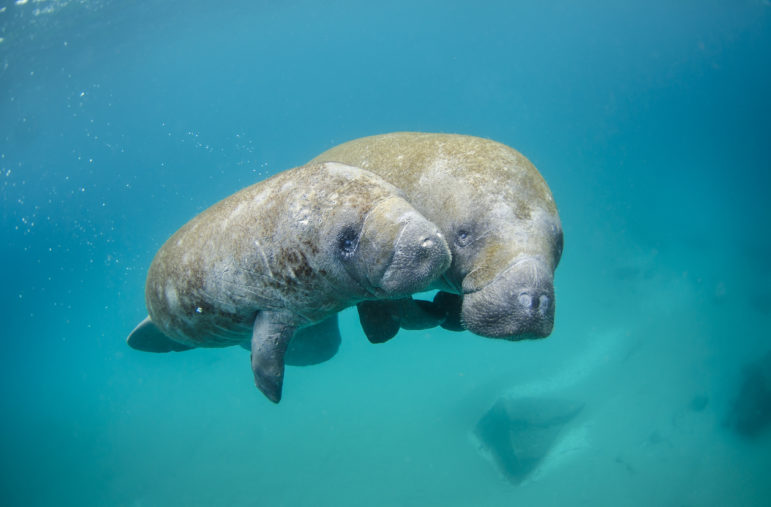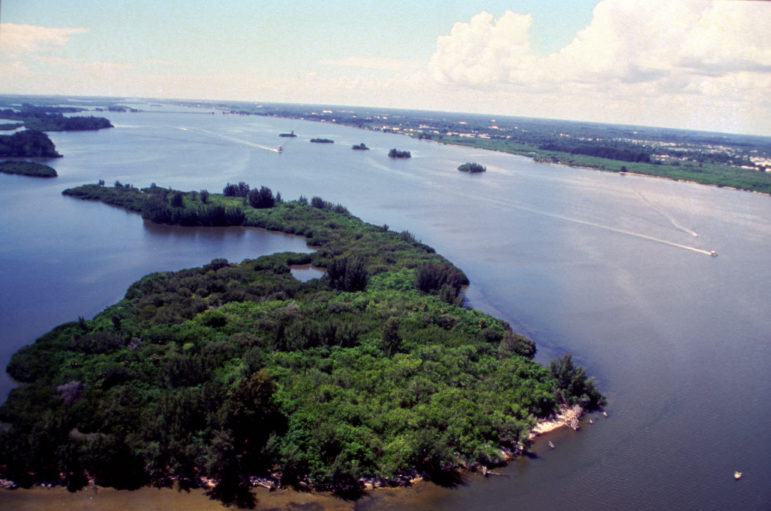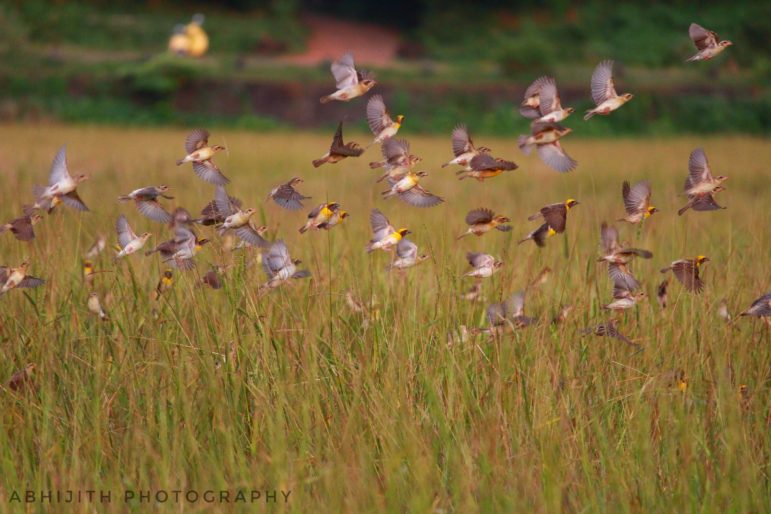TWH – This week, The Wild Hunt reports on two instances of the deadly impact of waste and pollution generated by commercial agriculture and human populations.
In one case, fertilizer run-off has damaged the primary food source of the manatee. That damage has led to 20% of the entire population of Atlantic Coast manatees dying since Jan. 1, 2021.
In another case, climate change will disrupt the seed dispersal patterns of most plant species. That disruption would cause an unknown number of plant species to become extinct.
Manatee deaths
The Florida Fish and Wildlife Commission reported that 479 manatees had died between January 1, and April 1, 2022. About 62% of those deaths occurred in the waters off of Brevard County alone. In 2021, 1,102 manatees died. In that year, 33% of those deaths occurred in Brevard County waters.

Manatee with calf – Image credit: Sam Farkas (NOAA Photo Library) – Public Domain
During the winter months, manatees, sensitive to cold, flock to warmer coastal waters. One of their favorite “hang-outs” is the Indian River Lagoon, off the coast of Brevard County. Part of the “space coast” of Florida, the John F. Kennedy Space Center drives the economy of Brevard County.
On March 25, 2022, WPBF reported the comments of Patrick Rose of the Save the Manatee Club on the 2022 manatee death toll.
Rose said, “We’ve lost in just the last 15 months more than 20% of the east coast population. There’s no quick solution, so we’re going to lose more and those manatees that do survive are going to be less fit. They’re going to have less offspring.”
Rose argued that runoff from poorly treated sewage, and fertilizers had fed algae blooms. Algae occur in nature. The excess nutrients from sewage and fertilizer runoffs upset the balance of the ecosystem. In response, the algae overproduce.
Algae blooms prevent sunlight from reaching the seagrass. Manatees feed primarily on seagrass. That lack of sunlight reduces the photosynthesis of seagrass. The crop of seagrass failed to grow. As the seagrass crop failed, manatees died of starvation.

Aerial view of Indian River Lagoon – Image credit: U. S. Fish and Wildlife Service – Federal Highway Administration. USDOT – Public Domain
Officials have begun a program to feed the manatees lettuce. Rose said that the program should be evaluated and modified to make it more effective. He also called for the U.S. Fish and Wildlife Service to improve standards for water quality. Improved standards would require increased penalties for violations. Rose expects this problem to continue and perhaps spread to Florida’s Gulf Coast.
The Center for Biological Diversity, Defenders of Wildlife, and Save The Manatee Club filed a lawsuit in the U.S. District Court in D.C. against the U.S. Fish and
Wildlife Service for failing to update data and criteria in order to preserve the habitat of manatees.
Climate change and species extinction
In the web of life, the loss of one species can have echoes throughout an entire ecosystem. Species co-evolve and are interdependent.
As the climate becomes warmer, animals and plants have several options. An unknown number of species will have to either move further from the Equator or move up higher on mountains. Other species will find barriers blocking their movement. Those barriers include things like non-crossable rivers and human settlements. Other species will evolve to meet the new hostile climate conditions. Some species will become extinct.
Animal species unique to small islands face a future like that of polar bears. They will be trapped on a steadily shrinking landmass with no way out.
Birds can fly over most barriers. They survived the extinction of the dinosaurs. Birds may also survive human-induced climate change.
If manatees can survive long enough, climate change might benefit them. With warmer waters, manatees would not have to flock to warmer, but polluted, coastal waters. Their habitat might also increase.
Rice University recently reported on a study about how climate change could disrupt plant seed dispersal by animals.
Plants lack locomotion. On their own, they cannot disperse their seeds away from their roots. Some plants evolved to rely on wind to disperse their seeds. More than half of all plants, however, evolved to embed their seeds in their fruit. Animals, including humans, like to eat that fruit. When those animals defecate, they disperse seeds along with manure.
Evan Fricke of the University of Maryland said, “Some plants live hundreds of years, and their only chance to move is during the brief period when they’re a seed moving across the landscape.”
Birds may be the only way that plants species unique to small islands might be able to survive. Avian populations could transport seeds to another island or maybe a large landmass.

Flock of munia in a paddy field in Palakkad District in Kerala, India – Image credit: Abhijith Photography – CC BY-SA 4.0
Enough seeds have to grow from animal defecation to ensure species survival. Frick said, “If there are no animals available to eat their fruits or carry away their nuts, animal-dispersed plants aren’t moving very far.”
That lack of mobility may doom certain plant species to extinction as their climate become less hospitable.
Researchers in the Rice study estimated the impact of various climate-change scenarios on distinct plant species in different regions. In their models, some animals would have a greater impact on seed dispersal than others did.
Frick said, “We found regions where climate-tracking seed dispersal declined by 95%, even though they’d lost only a few percent of their mammal and bird species.”
Large mammals and birds travel longer distances than smaller mammals and birds. As such, they may play a critical role, but their numbers are already dwindling.
As with much of climate change, this problem has a self-reinforcing quality. Frick said, “Biodiversity of seed-dispersing animals is key for the climate resilience of plants, which includes their ability to continue storing carbon and feeding people.”
As plants die off and plant species become extinct, they can store less carbon.
Increasing the number of green corridors between wild areas could help animals migrate to a climate becoming hospitable. Along the way, they could leave seeds. Those seeds would also have a better chance of species survival.
The waste and pollution generated by human populations have a variety of unintended consequences. Resolutions like the one introduced this month designating April National Native Plant Month can help raise awareness, as TWH wrote about last week. But whether society as a whole possesses the will to seriously address the consequences of pollution and a warming climate remains unknown.
The Wild Hunt is not responsible for links to external content.
To join a conversation on this post:
Visit our The Wild Hunt subreddit! Point your favorite browser to https://www.reddit.com/r/The_Wild_Hunt_News/, then click “JOIN”. Make sure to click the bell, too, to be notified of new articles posted to our subreddit.
